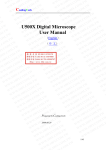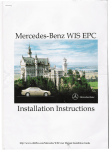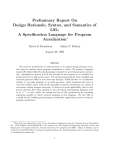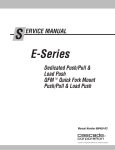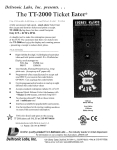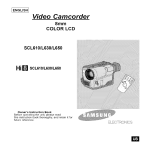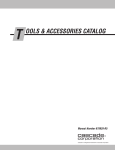Download VTech Push and Pull Hammer Truck Service manual
Transcript
Operator’s Guide 30D QFM™ Load Push/Pull WARNING: Lift truck forks are required to support the QFM™ Attachment and load. Manual Number 674520 R-1 cascade” Cascade is a Registered Trademark of Cascade Corporation l QFM is a Trademark of Cascade Corporation Contents Introduction ......................... Daily Inspection ..................... Safety Rules ........................ Load Requirements. .................. Load Handling Loading from Floor ................. Loading from a Stack ................ Unloading on Stacks ................ Loading from Pallets ................ Unloading on Pallets Pallet boards inline with push direction Pallet boards opposite push direction Loading from Truck Trailers .......... Unloading in Truck Trailers ........... Attachment Removal ................. Attachment Installation. ............... Attachment Operation Solenoid Adaption .................. Platen Adjustment. ................... i 4 6 8 10 . 11 12 13 14 15 16 18 18 Introduction This guide shows you how to operate the Cascade 30D QFMTM Push/Pull. It will also help avoid common errors which often cause damage to the equipment or the load being carried. Cylinders Faceplate \ I Read this booklet thoroughly BEFORE attempting to operate the attachment. If you have any questions or don’t understand a procedure described in this guide, ask your supervisor. The attachment components referred to in this operator’s guide are illustrated at right. The QFM Load Push/Pull is used mainly by receivers for unloading and transporting shipments on slipsheets with a maximum weight of 3000 Ibs. The QFMTM Push/Pull has the feature of being quickly installed or removed from the lift truck. This reduces costs by allowing one truck to handle both unitized slipsheet loads and palletized loads. A A Platens WARNING: Lift truck forks are required to support the QFMTM Attachment and load as illustrated. WARNING: Rated capacity of the truck/attachment combination is a responsibility of the original truck manufacturer and may be less than shown on the attachment nameplate. Consult the truck nameplate. ii Daily Inspection Perform the following visual and operation inspections daily before taking the attachment on the job. If item does not check out, report it to your supervisor. Do not operate the attachment on the job until all repairs have been made. See the Service Manual for procedures on repairs. Visual Inspection 0 Check to see that fittings are tight and that hoses are attached securely and do not leak. Cl Check for tightness and correct mounting of mounting bolts, capscrews, nuts, and hooks. Cl Check the platen tips for nicks or other damage. Repair immediately. Flatten out nicks with a hammer and smooth the edges with a file or grinder. Apply wax or paraffin to the top surfaces of the platens to reduce friction between platens and slipsheets. Use steel wool to remove excess wax. Operation Inspection Perform the following inspections, first without a load, and again after picking up a load. 1 0 Check to be sure the faceplate moves in and out smoothly and is not misaligned. DO NOT attempt to pull a load onto the platens with a misaligned faceplate. 0 Check to be sure the capscrews that hold the platens on the lower bar are tight. Safety Rules A A Drive carefully and observe traffic rules. Be in full control of the truck at all times. Avoid ruts, bumps, and other hazards that may cause the truck to swerve or tip. A Travel slowly around corners. Sound horn on blind corners. Be careful of tail swing and overhead clearances. Watch where you are going, whether in forward or reverse. Avoid sudden stops and starts. A A Never leave a lift truck unattanded without lowering the load to the floor, setting the brake, and turning the truck off. A A A A A A A A A A A A A WARNING: Lift truck forks are required to support the QFMTMAttachment and load. Always back down ramps or inclines. Driving forward down a ramp or incline with a load will reduce the truck’s stability. Do not allow riders on the truck or platens at any time. Do not lift or hit anything that may fall. Never allow anyone under a load or under the carriage. Never reach through the mast. Keep all parts of your body inside the driver’s compartment. Transport a load with the attachment 3-4 inches from the ground and the mast tilted back. Limit the amount of truck maneuvering to a minimum when high-stacking a load. Report all damaged or faulty equipment. Do not operate a lift truck or QFMTM Push/Pull until repairs have been made. Do not overload the lift truck. Make sure the load is within the attachment and trucks rated capacity, whichever is lower. Do not open boxcar doors with this attachment. Do not grip anything other than slipsheets with the gripping bar. Do not use the QFMTM Push/Pull as a “bulldozer” or a ram. Perform the Daily Visual and Operation Inspections on page 1 before using the attachment on the job. If in doubt about any procedure in this book, ask your supervisor. 2 Load Requirements Slipsheet Unitized Loads Loads must be stacked on the slipsheet tightly together and spaced l/4” behind the bend of the slipsheet tab. Loads to be transported in truck trailers should have the load stretch wrapped or have the top row of the load strapped for load stability. Slipsheets with skid resistant coating or an application of this coating to the slipsheet or load is recommended. The coating reduces sliding of the load on the slipsheet during transit. Always enter the load with the platens at a downward angle, otherwise the tips will gouge the load. Pick up unitized loads or firmly stacked loads. Do not pick up-sloppy or poorly distributed loads. 3 Load Handling Loading from Floor 1 n Line up the platens squarely with the load. Extend the faceplate. Raise the platens about 3” above the floor. Tilt the mast forward until the tips of the platens touch the floor. 2 n DO NOT try to pick up a load with the platens flat on the floor. Doing so may rip the slipsheet and/or gouge the bottom layer of cartons. Drive the truck forward until 3 the slipsheet tab fits into the gripper channel opening. n 4 Load Handling Loading from Floor (cont.) Retract the faceplate. The gripper bar will automatically clamp the slipsheet tab. Move forward slowly as the load is being pulled onto the platens. 4 l After pulling the load onto the platens, tilt the mast back and raise the load 3 “-4” above the floor. You are now ready to transport the load. 5 5 n Load Handling Loading from a Stack 1 n Line up the platens squarely with the load. Extend the faceplate. Raise the platens to just above the slipsheet of the load you are picking up. Tilt the mast forward 3 “-4 O. 2 n Drive the truck forward until 3 the slipsheet tab fits into the gripper channel opening. n NOTE: The faceplate is designed to tilt back 4’ so that it fits flat against the load. 6 Load Handling Loading from a Stack (cont.) Apply the truck brakes and retract the faceplate. The gripper bar will automatically clamp the slipsheet tab. Pull the load onto the platens. As the load is pulled onto the platens, they will deflect downward. Raise the carriage slightly to compensate for the platen deflection. 4 n DO NOT allow the truck to be pulled forward. The platen tips may gouge the load underneath. OPTIONAL METHOD Drive the truck forward as the load is being pulled onto the platens. Tilt the mast back and lower the load to 3”-4” above the floor. You are now ready to transport the load. 5 7 m Load Handling Unloading on Stacks 1. Position the load 4” above where it is to be discharged. 2. Tilt the mast forward 3 ’ to 4 O. Lower the platens until the platen tips are about l/2” above the discharging area. 3 n 8 Load Handling Unloading on Stacks (cont.) Place the truck’s transmission in neutral and start the pushing operation. The gripper bar will automatically release the slipsheet tab. As the faceplate moves the load off, the truck will move backward (with light loads drive backward slowly). As the weight is withdrawn from the platens they will deflect upward slightly. Compensate for this by lowering the platens. 4 l NOTE: If your truck does not operate in neutral, place the transmission in reverse and drive backward slowly to coordinate the pushing motion with the reverse movement. 5 l Match the facing edge and corners with the load below. Back away, tilt the mast back and raise or lower the platens to 3”-4” above the floor for traveling. 6 9 l Load Handling Loading from Pallets Tilt mast forward 3”-4”. Position the slipsheet tab in the gripper channel opening. 1N Grip the slipsheet tab and raise the platen tips 1 n to allow the platens to enter between the slipsheet and pallet. Retract the faceplate and drive forward at the same rate the load is being pulled onto the platens. 2. Tilt the mast back and back away from the pallet. Lower the load to 3 “-4 Wabove the floor. You are now ready to transport the load. 3. 10 Load Handling Unloading on Pallets (Pallet Boards lnline with Push Direction) 1 l Position the load squarely 3” above and l/2 over the pallet. Tilt mast forward 3” to 4”. Lower the platen tips onto the pal&. Push the load until it is squarely centered on the pallet. 2 Lift platens slightly. Reverse truck and back away from load at &me speed as load is being pushed off. 3 11 Load Handling Unloading on Pallets (Pallet Boards Opposite Push Direction) Position the load squarely 3” above and 4” from the edge of the pallet. 1 n Tilt mast forward 3” to 4”. Lower platen tips to 112 Nabove the pallet. 2. Push load face to front edge of pallet. Reverse truck and back away from load at same speed as load is being pushed off. 3 n 12 Load Handling Loading from Truck Trailers CAUTION: Trailer wheels must be blocked. Read the section for loading from the floor and use the following special techniques. The first loads at the back of the trailer can be removed without a dock plate if the stacking of the loads does not allow proper installation of the dock plate. All remaining loads will require the dock plate. 1= Sideshift away from the trailer wall once the load is on the platens. If the loads have shifted during shipment and become interlocked, sideshift back and forth to make room for load removal. 2 13 n Load Handling Unloading in Truck Trailers CAUTION: Trailer wheels must be blocked IMPORTANT: Unit loads should be stabilized by using strapping or stretch wrap. Drive into the trailer and position back of load 12” from face of forward load. Sideshift load against trailer wall. 1. Tilt mast forward 3” to 4”. Lower platen tips to the floor. Place truck transmission in neutral. Push load off platens up against forward load. The slipsheet tab on forward loads must be in the UP position. 2. When there is excessive air space between the final loads and the trailer door, add spacing material or air bags between the final loads. This will hold the loads against the trailer walls and prevent load shifting. 3 l 14 Attachment Removal Extend the faceplate to approxl imately 3/4 of its travel on the platen. Position the attachment 2 feet off the ground with the mast in the true vertical position. 1 Position faceplate at 314 travel. Pull out the lower hook locking pins. Swing the lower mounting hooks down and lock in the disengaged position. Push in lower pin. 2 Pull out locking pins. Rotate hooks down and lock in place. n A Raise attachment 2 feet (60 cm). WARNING: Before removing any hoses, relieve pressure that might be present in the hydraulic system. With the truck off, open the truck auxiliary control valve(s) several times in both directions. Push Disconnect the quick disconn nect hydraulic couplers at the truck carriage. 3 Pull ( 1 \ -To Hose Reil u IW Place a 2 “x4 N block (15 ” long) on the floor under the platen tips. Lower the attachment to the ground. Back the truck away from the attachment. 4 l Upper Carriage Bar Upper Hook r Lower hooks must be in the down position. 15 1 Attachment Installation WARNING: Adjust the truck forks to a . measurement of 22.5-25.5 in. between the inner edges of the forks. Engage the fork detent pins. 1 22.525.5 (57-6 Position Position the truck carriage in the true vertical position. Lower the forks to the ground. Center the truck carriage behind the attachment. Drive forward to fully engage the truck upper carriage bar with the attachment upper hooks. Raise the attachment 1 or 2 in. carriage and forks. 2. 2x4 to eye hook up and lock in place. The hooks must be adjusted for 1116 in. clearance with the lower carriage bar. If necessary, adjust the hooks and tighten the capscrews to a torque of 55-65 ft.-lbs. Make sure the hooks swing down and lock properly for attachment removal. ‘Lower hooks must be in the down position. Pull out locking pins. Rotate hooks up and lock in place. Raise the attachment 3 . level. Pull out the lower locking pins. Rotate the hooks Adjust hooksfor l/16 in. clearance. Tighten capscrews to a torque of 55-65 ft.-lbs. Mounting H‘ook Capscrews 16 Attachment Installation Connect the attachment hoses to the truck quick change hydraulic couplers. Route the hoses to avoid interference with the mast. 4 n Upper Carriage In order to conform to industry standard practice, the hoses should be connected to the truck auxiliary valve as indicated by the chart. r Function, in sequence of location to the operator Attachment Movement I Sideshift (when equipped) Push/Pull* Sideshift Sideshift Right Left Pull (rearward) Push (forward) Motion of the operator’s hand when actuating the truck auxiliary control handle while facing the load. Rearward or Up Forward or Down Rearward or Up Forward or Down * Trucks equipped with a single function auxiliary control valve and solenoid adaption require the control knob electrical button to be depressed for operation of the push/pull function. 17 Bar Attachment Operation Solenoid Adaption Solenoid adaption allows two function controls for a single auxiliary valve lift truck. Two Function The addition of two function solenoid adaption (674303) allows the operator to control the push/pull function and the sideshift function with the same lever. A special knob, with a push button, is installed on the truck lever. To sideshift, move the lever forward to sideshift left and backward to sideshift right, The button must be pressed to engage the push/pull function. Platen Adjustment The inside spacing between the platens can be adjusted to 4 in. or 10 in. as required. Remove the platen capscrews and nuts. Move the platens to line up with the other set of predrilled holes. Install the capscrews and nuts. Tighten to a torque of 35-45 ft.-lbs. Tighten to a to 4 or 10 in. 18 OSHA Regulations Industrial Trucks and Attachments (Specific Regulations from OSHA 1910.178) A WARNING: The safe operation and maintenance of industrial trucks is regulated by Occupational Safety and Health (OSHA) regulations 1910.178 and American National Standards Institute (ANSI) Safety Standard for Powered Industrial Trucks, ANSI 856.1-1969. When operating and maintaining industrial trucks equipped with attachments you should pay particular attention to the following sections of these regulations. You should be familiar with all sections of these regulations. Ask your employer for the complete regulations. (a) General Requirements (4) Modifications and additions which affect capacity and safe operation shall not be performed by the customer or user without manufacturers prior written approval. Capacity, operation and maintenance instruction plates, tags or decals shall be changed accordingly. (5) If the truck is equipped with front-end attachments other than factory installed attachments, the user shall request that the truck be marked to identify the attachments and show the appropriate weight of the truck and attachment combination at maximum elevation with load laterally centered. (6) The user shall see that all nameplates and markings are in place and maintained in a legible condition. (e) Safety Guards (2) If the type of load presents a hazard, the user shall equip fork trucks with a vertical load backrest extension in accordance with (a)(2) following. (a)(2) All new powered industrial trucks acquired and used by an emplo er after February 15, 1972 shall meet the design and construction requirements Yor powered industrial trucks established In the ‘American National Standard for Powered Industrial Trucks, Part II, ANSI B56.1-1969”, except for vehicles intended primarily for earth moving or over-the-road hauling. (I) Operator Training Only trained and authorized operators shall be permitted to operate a powered industrial truck. Methods shall be devised to train operators in the safe operation of powered industrial trucks. (m) Truck Operations (1) Trucks shall not be driven up to anyone standing in front of a bench or other fixed object. (2) No person shall be allowed to stand or pass under the elevated portion of any truck, whether loaded or empty. (3) Unauthorized personnel shall not be permitted to ride on powered industrial trucks. A safe place to ride shall be provided where riding of trucks is authorized, (4) The employer shall prohibit arms or legs from being placed between the uprights of the mast or outside the running lines of the truck. (5i) When a powered industrial truck is left unattended, load en agin means shall be fully lowered, controls shall be neutralized, power shall be sYlut ow and brakes set. Wheels shall be blocked if the truck is parked on an incline. awa (5ii) A powered industrial truck is unattended when the operator is 25 feet or more from the vehicle which remains in his view, or whenever the operator leaves the vehicle and it is not in his view. OSHA Regulations (5iii)When the operator of an industrial truck is dismounted and within 25 feet of the truck still in his view, the load engaging means shall be fully lowered, controls neutralized and the brakes set to prevent movement. (6) A safe distance shall be maintained from the edge of ramps or platforms while on any elevated dock or platform or freight car. Trucks shall not be used for openrng or closing freight doors. (1O)A load backrest extension shall bs used whenever necessary to minimize the possibility of the load or part of it from falling rearward. (n) Traveling (4) The driver shall be required to slow down and sound the horn at cross isles and other locations where vision is obstructed. If the load being carried obstructs forward new, the driver shall be required to travel with the load trailing. (7i) When ascending or descending grades in excess of 10 percent, loaded trucks shall be driven with the load upgrade. (7iii)On all grades the load and load engaging means shall be tilted back if applicable, and raised only as far as necessary to clear the road surface. (0) Loading (1) Only stable or safely arranged loads shall bs handled. Caution shall be exercised (2) (3) (4) (5) when handling off-center loads which cannot be centered. Only loads within the rated capacity of the truck shall be handled. The long or high (including multiple-tiered) loads which may affect capacity shall be adjusted. Trucks equipped with attachments shall be operated as partially loaded trucks when not handling a load. A load engaging means shall be placed under the load as far as possible; the mast shall be carefully tilted backward to stabilize the load. (6) the load forward or backward, particularly means elevated shall be (p) Operation of the Truck (1) If at any time a powered industrial truck is found to be in need of repair, defective, or in any way unsafe, the truck shall be taken out of service until it has been restored to safe operating condition. (q) Maintenance of Industrial Trucks (1) Anv oower-ooerated industrial truck not in safe ooeratina condition shall be removed from&vice. All repairs shall be made by authorized p&sonnel. (5) All parts of any such industrial truck requiring replacement shall be replaced only by parts equivalent as to safety with those used in the original design. (6) Industrial trucks shall not be altered so that the relative positions of the various parts are different from what they were when originally received from the manufacturer, nor shall they be altered either by the addition of extra parts not provided by the manufacturer or by the elimination of any parts. Additional counter-weighting of fork trucks shall not be done unless approved by the truck manufacturer. (7) Industrial trucks shall be examined before being placed in service and shall not be placed in service if the examination shows any condition adversely affecting the safety of the vehicle. Such examinations shall be made at least daily. When industrial trucks are used on a round-the-clock basis, they shall be examined after each shift. Defects when found shall be immediately reported and corrected. 0 Cascade Corporation 1992 10/92 Part No. 206633 Do you have questions you need answered right now? Toll Free Directline 800-CAS-CADE (227-2233) @Cascade Corporation 1986 3-86 Part No. 674520 R-1
























